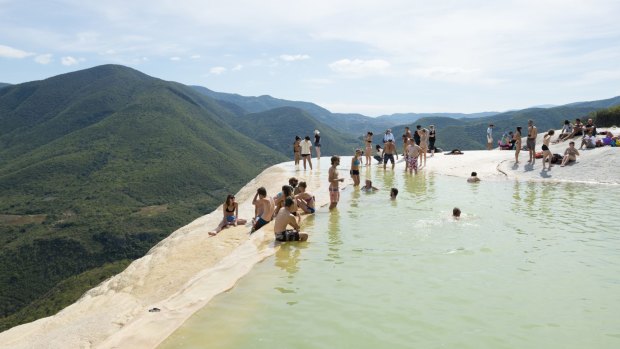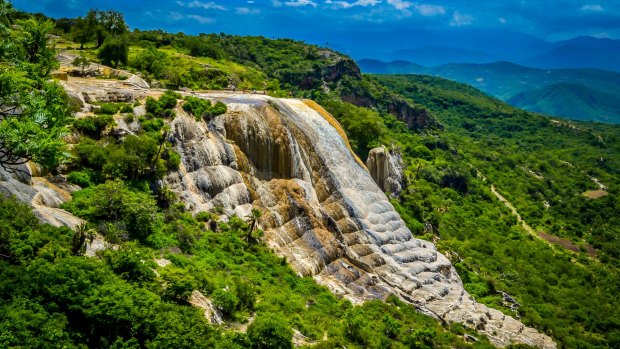This was published 4 years ago
Hierve el Agua, Mexico, Oaxaca: A rare natural phenomenon
By Alison Stewart

Tourists enjoy the water and dramatic scenery at Hierve el Agua in Oaxaca State, Mexico.Credit: iStock
What boils and is cold enough to touch? What flows and is motionless? What is ancient but constantly renewing? What freezes in blazing heat? Solve the riddle and you will arrive at a sacred place – the petrified waterfalls of Mexico's Hierve el Agua.
Its name means "the water boils" and while it does indeed bubble to the surface in the pools that feed the falls, it is cool – between 22 to 25 degrees. These two "waterfalls" set in the high, remote mountains of the southern Oaxaca region, seem to tumble into the valley below, the majestic drops clearly defined. Yet they are solidified torrents, frozen to resemble Arctic ice waterfalls.
Hierve el Agua's natural rock formations are formed by freshwater springs saturated with calcium carbonate and other minerals. As the water flows over the cliff, the minerals are deposited to form solid falls, much like stalactites.

Hierve el Agua's natural rock formations are formed by freshwater springs saturated with calcium carbonate and other minerals. Credit: iStock
Little was known of the Cascadas de Hierve el Agua until the 1994 US FINA World Cup when Mexico's Corona beer used the frosty white waterfalls in a video advertisement to replicate an overflowing head of beer. To visit this rare natural phenomenon – there's another in Pamukkale, Turkey – requires a two-hour journey south-east from Oaxaca City, the last half hour or so on a rough mountain road.
Historically, this is indigenous Zapotec country. Their pre-Colombian, 2500-plus-year civilisation flourished in Mesoamerica's Valley of Oaxaca. Mesoamerica was a geographic region that prospered before Spanish colonisation and extended from central Mexico through Belize, Guatemala, El Salvador, Honduras, Nicaragua and northern Costa Rica.
Hierve el Agua, at 1821 metres in the heart of the Sierra Madre del Sur, was sacred to the ancient Zapotec. Its water nourished their crops within a mountainous region of extreme seasonal aridity. They built a complex irrigation system here, an extensive webbing of lined canals and terraces cut into the sides of the mountain cliffs. The irrigation system is considered unique in Mesoamerica and its vestiges continue to interest archaeologists, biologists and geologists. Irrigation was unusual in pre-Hispanic Mexico.
It's hard to imagine that these scorched mountains marching towards an Oaxacan horizon are green-furred during the May to November rainy season. During our March visit, the heat and dust shimmer ruthlessly.
Still, our group is keen not simply to observe the admittedly remarkable spectacle of the blue-green pools and calcium carbonate deposits that step down the mountain, but also to hike the circular one-hour loop to properly appreciate the two petrified waterfalls – the 12-metre cascada chica (small cascade) and the 30-metre cascada grande.
The Hierve el Agua site consists of two rock shelves, or cliffs, rising 50 metres to 90 metres from the valley. The glowing white petrified falls also known as "cascadas de sal" (salt waterfalls) and "cascadas petreas" (rock waterfalls) extend from the rock shelves.
The first rock shelf hosts the small cascade, also known as "El Anfiteatro" (the amphitheatre) and has two large artfully created swimming pools and a number of natural pools. One of the artificial pools teeters at the cliff edge, resembling an infinity pool. The small cascade flows off a 60-metre-wide shelf while the large waterfall extends from a 90-metre-wide shelf.
The best way to properly appreciate both waterfalls is to take the trail from the small cascade to the large one. It's a steep descent over rough terrain through cactus, sparse and scrubby holm oak and semi-desert vegetation including what our guide calls the "bad woman" plant. Touch it and it bites.
Cacti, yucca, agave and grasses stand against what romance novelists might call a pitiless blue sky – copious water and sunscreen are required. At every turn, the huge, many-armed garambullo blanco cactus punches the sky while the single-leaved maguey verde grande, the world's largest agave species, perches drunkenly on precipices.
The hike reveals more infinity pool-shelves and the two waterfalls seen from various spectacular aspects. The most impressive offers a close-up of the largest waterfall whose frozen falls resemble the spines of an ancient agave.
Our guide from the nearby village of San Lorenzo Albarradas, perhaps feeling the heat, takes off like a mountain goat directly up the mountain to the upper pools, a hair-raising vertical scramble.
Once restored to safety, some of us swim, some paddle, taking in the views of the valley and the cruising zopilotes, condoresque, black Mexican vultures, circling above the valley floor as they have done for thousands of years.
THE DETAILS
Alison Stewart was a guest of Intrepid Travel.
MORE
FLY
Qantas flies daily from Sydney to Mexico City via Dallas (includes an American Airlines code share) and Cancun to Sydney via Dallas. See qantas.com
TOUR
The Hierve el Agua expedition is part of Intrepid Travel's 15-day Best of Mexico trip that starts in Mexico City and ends in Playa del Carmen. The trip includes accommodation, transport, most meals and activities, and an expert local guide. From $3770 a person twin share. See intrepidtravel.com/au
See also: This place is so cold, the waterfalls freeze solid
Sign up for the Traveller Deals newsletter
Get exclusive travel deals delivered straight to your inbox. Sign up now.